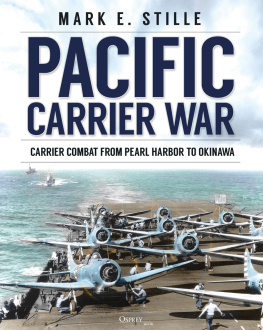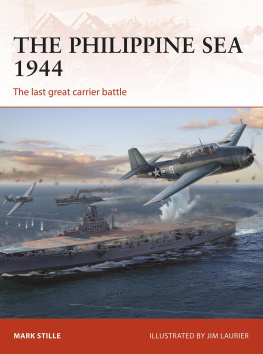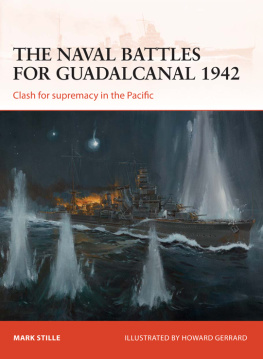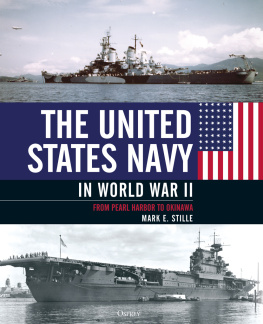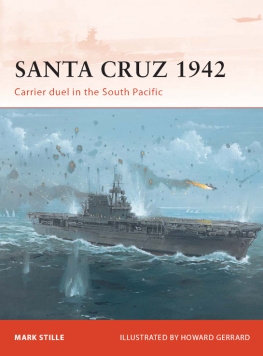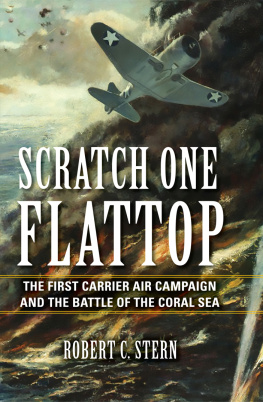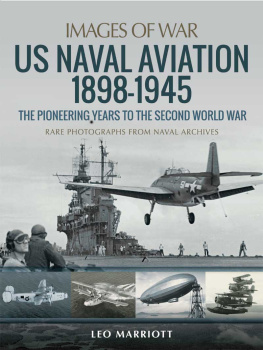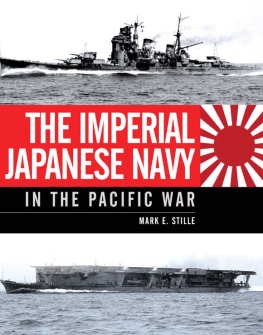
OSPREY PUBLISHING
Bloomsbury Publishing Plc
Kemp House, Chawley Park, Cumnor Hill, Oxford OX2 9PH, UK
29 Earlsfort Terrace, Dublin 2, Ireland
1385 Broadway, 5th Floor, New York, NY 10018, USA
E-mail:
www.ospreypublishing.com
This electronic edition published in 2021 by Bloomsbury Publishing Plc
OSPREY is a trademark of Osprey Publishing Ltd
First published in Great Britain in 2021
Mark E. Stille, 2021
Mark E. Stille has asserted his right under the Copyright, Designs and Patents Act, 1988, to be identified as Author of this work.
All rights reserved
You may not copy, distribute, transmit, reproduce or otherwise make available this publication (or any part of it) in any form, or by any means (including without limitation electronic, digital, optical, mechanical, photocopying, printing, recording or otherwise), without the prior written permission of the publisher. Any person who does any unauthorised act in relation to this publication may be liable to criminal prosecution and civil claims for damages.
A catalog record for this book is available from the British Library.
ISBN: 978-1-4728-2633-6 (HB)
ISBN: 978-1-4728-2635-0 (eBook)
ISBN: 978-1-4728-2634-3 (ePDF)
ISBN: 978-1-4728-2636-7 (XML)
Cover design, Art Direction and layout by Stewart Larking (Osprey)
Maps by www.bounford.com
Osprey Publishing supports the Woodland Trust, the UKs leading woodland conservation charity.
To find out more about our authors and books visit www.ospreypublishing.com. Here you will find our full range of publications, as well as exclusive online content, details of forthcoming events and the option to sign up for our newsletters. You can also sign up for Osprey membership, which entitles you to a discount on purchases made through the Osprey site and access to our extensive online image archive.

CONTENTS

This photograph shows a group of Helldivers and Avengers on their way to attack the First Mobile Fleet on the afternoon of June 20, 1944. The shorter-ranged Helldivers suffered heavily on this mission. Of the 51 that participated in the attack, four were lost in combat and 39 were lost operationally for an overall loss rate of 84 percent. (Naval History and Heritage Command)
I t would be an exaggeration to say that the Pacific War was decided by the five carriers that fought during the conflict, but perhaps not much of an exaggeration. At the start of the war, both sides still largely believed that a decisive battle between the Imperial Japanese Navy (IJN) and the United States Navy (USN) would be determined by a climactic clash of battleships. This view was not universally held within each navy, as shown by the Japanese creation of an independent carrier force the First Air Fleet in April 1941, and prewar American experimentation with independent strike groups built around carriers. Both sides recognized the importance of naval air power, and both had built very different carrier forces.
Facing a numerical disadvantage created by the interwar system of naval treaties and Japans industrial inferiority, the IJN created a carrier force based on achieving a qualitative edge over the USN. This edge was created by establishing a cadre of highly trained aviators the most highly trained in the world and designing aircraft capable of striking at longer ranges than their American counterparts. Creation of the First Air Fleet was a force multiplier since, by the summer of 1941, it combined six fleet carriers into a single operational entity. This ability to mass naval air power was a game changer, as demonstrated at Pearl Harbor and other places during the opening months of the war. Had the Japanese maintained the cohesion of the First Air Fleet during this initial period, the history of the war would have turned out much differently.
As the Japanese massed naval air power, the Americans still operated carriers singly. Some American admirals saw the benefits of massing multiple carriers into a single task force, but most preferred to keep them separated to avoid detection and destruction. Operating singly, or even in pairs, American carriers lacked the striking power of the First Air Fleet. Also impacting their striking power was the short range of American carrier aircraft and the almost total ineffectiveness of the standard torpedo bomber and its torpedo.
The IJNs carrier force had a predictable run of successes in the first few months of the war. Their apparent smashing victory at Pearl Harbor was followed by more success at Rabaul, the Dutch East Indies, Darwin, Australia, and finally by a massive raid into the Indian Ocean. However, the only time during the war that the Japanese operated all six of their prewar fleet carriers in a single formation was at Pearl Harbor. This lack of concentration gave the Americans an opportunity to defeat the First Air Fleet piecemeal. The First Air Fleet was set up for destruction by bad operational planning by the most overrated admiral of the war Yamamoto Isoroku not by a lack of tactical prowess.
At the battle of the Coral Sea, American Admiral Chester Nimitz aggressively sought an opportunity to engage the Japanese carrier force. The appearance of American carriers in the South Pacific in March 1942 forced the Japanese to send carriers to the region to protect any further advances. To cover his next operation, Yamamoto allocated only two fleet carriers and a light carrier to seize Port Moresby. For his part, Nimitz was prepared to send all four of his operational carriers to the South Pacific, but the raid on Tokyo held up two carriers, leaving only two to deal with the massive Japanese incursion into the Coral Sea. The resulting first carrier battle was a very confused affair with both sides having and wasting opportunities to launch an all-important first strike. When the preliminaries were over, both sides finally struck the others main carrier force on May 8, 1942. The exchange was deadly, but the prewar notion that carriers were extremely vulnerable to air attack was proven incorrect. One American fleet carrier was sunk, and another damaged. Japanese losses were much heavier. The light carrier was sunk, one of the fleet carriers bombed and heavily damaged, and the second fleet carrier had its air group so attrited that it was considered by the Japanese to be incapable of operations. Thus, of the 11 IJN carriers operational before the battle, only eight remained available for the next, and most famous, carrier battle.
The battle of the Coral Sea was just a preface to Yamamotos major operation the following month. This operation was targeted on Midway Atoll but was actually focused on annihilating Nimitzs remaining strength in a decisive battle. Through a series of astoundingly bad decisions, the remaining four Japanese fleet carriers were actually outnumbered at the point of contact against Nimitzs three fleet carriers and the many aircraft stationed on Midway. Using exquisite intelligence, and insightfully positioning their carriers where they could strike the Japanese, the Americans pulled off the only successful ambush during any of the wars carrier battles. Despite major issues in coordination and communication that threatened to derail Nimitzs ambush, fate placed the Americans most powerful weapon, their dive-bombers, over the Japanese carriers at the point they were most vulnerable. The result was the bombing of three carriers within the span of minutes, all of which later sank. A single remaining Japanese fleet carrier acquitted itself well, heavily damaging an American carrier that was later finished off by an American submarine, before it was also sunk. The battle of Midway was not the kind of decisive battle that Yamamoto was planning for. At its conclusion, the IJNs offensive power in the Pacific was blunted. But it was not the end of the IJNs carrier force, as is often suggested.

